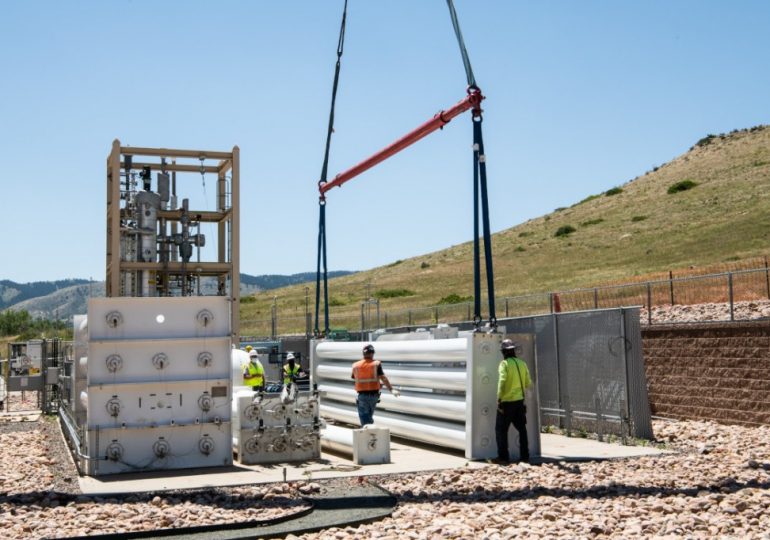As the federal government rolls out billions of dollars in subsidies to produce hydrogen fuel for use in vehicles, factories and power plants, a growing body of evidence is undercutting its clean credentials.
The U.S. Department of Energy recently awarded $7 billion to seven regional hydrogen production hubs, on top of a lucrative tax credit whose rules have become the subject of intense industry lobbying.
Meanwhile, scientists and advocates are warning that the government’s rush to scale hydrogen has not adequately considered the fuel’s climate risks, including the potential of leaked hydrogen to prolong the heat-trapping impact of methane and act as a greenhouse gas itself when it creates water vapor in the upper atmosphere.
Multiple studies have also found burning hydrogen in power plants increases formation of nitrogen oxides (NOx), a pollutant that causes smog, harms public health, and also contributes to warming.
Hydrogen is “an indirect global warming gas,” said David Schlissel, an analyst who has testified before the U.S. Federal Energy Regulatory Commission, the Nuclear Regulatory Commission and numerous state commissions on energy issues. “It increases the lifetime of methane in the atmosphere. And if you burn it in a power plant, you produce a lot of NOx, which leads to smog.”
A national coalition of environmental justice organizations are among those seeking to explain this science and demand more accountability for hydrogen’s complicated climate impacts. The Just Solutions coalition released a report last month by the Institute for Energy and Environmental Research exploring the emissions and water use implications of increasing our reliance on hydrogen for fuel and power.
Similar concerns and findings were revealed in recent research by Cornell University scientists and by the Institute for Energy Economics and Financial Analysis, where Schlissel is an analyst.
Different uses, different concerns
When pure hydrogen is combined with oxygen in hydrogen fuel cells, electricity is produced and the only byproducts are water vapor and heat. Such fuel cells can be used as power plants – sending electricity to the grid – or they can power vehicles like trucks or locomotives. A hydrogen fuel cell car, for example, is essentially an electric car with a built-in charging source.
Pure hydrogen can also be burned to power electricity generation or industrial processes, similar to natural gas combustion but without directly creating pollution that causes climate change or harms public health. Hydrogen can be combined with natural gas or burned in converted natural gas power plants.
Pure hydrogen today is produced mostly from natural gas, resulting in carbon emissions. If that carbon is sequestered, it is known as blue hydrogen. If hydrogen is produced from water in a process powered by renewables, known as green hydrogen, theoretically few greenhouse gas or other emissions result.
But advocates have questioned the viability of large-scale carbon sequestration as well as the ripple effects of diverting renewable power to make hydrogen from water.
And then there are the more complicated ways that hydrogen could increase greenhouse gas and public health-harming emissions, scientists and community leaders say.
Even if hydrogen production, combustion and fuel cell use does not directly release greenhouse gas, it could contribute to climate change because of the way it interacts with or affects other elements in the atmosphere.
If hydrogen is to be used for everything from power generation to fuel cells to industrial processes, it will need to be produced at hydrogen plants and then usually transported and stored. Similar to natural gas, there’s ample potential during this process for pure hydrogen to “leak” into the atmosphere.
When that happens, pure hydrogen can have a complicated effect on the concentration of the powerful greenhouse gas methane in the atmosphere, an effect that hasn’t been adequately considered in federal policy, explains nuclear engineer Arjun Makhijani, co-author of the IEER report and author of Mending the Ozone Hole, by MIT Press.
‘Cleaning up’ methane
Single-bonded hydrogen and oxygen atoms are known as hydroxyl radicals (HO) that “clean up” methane and other gases in the atmosphere by oxidizing and transforming them. Hydroxyl radicals decompose methane this way. But when pure hydrogen (H2) is released into the atmosphere, it also is broken down by these hydroxyl radicals, meaning they are less available to break down methane.
Hydroxyl radicals are “the main cleanser of atmospheric chemical pollution, with a lifetime of about a second — it’s that active — compared to methane which has a half-life of (about) 9 years,” said Makhijani. When hydroxyl radicals are “used up” breaking down pure hydrogen, there are fewer of them to break down methane.
This effect is considered to account for half of the global warming potential represented by hydrogen, the IEER study says.
“If you’re producing hydrogen and it leaks a lot, you’re going to increase methane concentrations even if methane emissions do not increase,” said Makhijani. “It’s like you’re stopping up the toilet.”
Also, when hydrogen is released into the atmosphere, some of it ends up transforming into water vapor in the stratosphere. While water vapor in the lower troposphere does not cause warming, vapor higher up in the atmosphere creates a greenhouse effect of its own. This is thought to account for about 30% of the warming potential of hydrogen, IEER reports.
Meanwhile when combusted to produce electricity or power industrial processes, hydrogen burns very hot. That heat drives oxygen and nitrogen in the atmosphere to form NOx, a pollutant that creates smog and harms public health while also contributing to global warming. This effect is considered to represent about 20% of the warming potential of hydrogen, IEER reported.
When hydrogen is blended with natural gas for use in heating or electricity generation, the formation of NOx can be significantly greater than when gas alone is burned, multiple studies have found.
“NOx emissions are not the only reason why burning hydrogen to make electricity is a bad idea — it is also wildly inefficient and hard to do,” said Lauren Piette, a senior associate attorney in the clean energy program for Earthjustice.
“Burning green hydrogen in a gas plant to make electricity is like using a Rube Goldberg machine to strike a match. You take all this zero-carbon energy from solar and wind, use it to power an energy-hungry electrolyzer to make hydrogen, then burn that hydrogen in a gas plant to make a significantly smaller amount of electricity than you started with.”
Hydrogen can be mixed with natural gas to be burned in turbines or to fire traditional steel-making blast furnaces. Many clean energy advocates consider this to be an inefficient use of hydrogen, since the reduction in greenhouse gas emissions is relatively moderate and can be dwarfed by the lifecycle greenhouse emissions related to producing and transporting hydrogen.
“You’re spending a lot of money to make hydrogen from natural gas and then using it for the same purpose as natural gas — so why not just burn the gas,” said Makhijani.
Estimating leakage
A significant part of this equation is the rate of leakage — of both natural gas and hydrogen during transport and storage.
Natural gas typically leaks from pipelines and storage tanks at an average rate of about 2.7% of its volume, according to a 2018 paper in Science. Other peer-reviewed studies have found similar leakage rates. However the Argonne National Laboratory’s GREET model, used by the federal government to define standards for clean hydrogen, assumes a 1% natural gas leakage rate. Experts have demanded that federal models and rules be adjusted to reflect higher expected leakage rates.
“The government is playing a shell game — they have set up their GREET model to show that blue hydrogen with carbon capture is close to being clean,” said Schlissel. “That only works if you make extremely optimistic and unrealistic assumptions about upstream methane leakage.”
Hydrogen is a lighter, less concentrated gas, so it takes up more room — proportionate to its energy value — than natural gas.
This means squeezing enough hydrogen into a pipeline or storage tank to compensate for the natural gas it is replacing will increase the pressure on the infrastructure. And increased pressure means more likelihood of leaks.
Because of its expansive volume, hydrogen is often compressed for storage or transportation in tanks; it can also leak during this process.
“A recent analysis by Columbia University has estimated current leakage rates at around 2.9%” for hydrogen, Abbe Ramanan, project director for the Clean Energy Group, noted in a 2023 article for Utility Dive. “However, the push to produce more hydrogen — and deploy it in more leak-prone use cases, like pipelines — could push economy-wide leakage rates to 29.6 million tons or 5.6% of all hydrogen produced by 2050.”
To qualify as “clean,” the Department of Energy says “well to gate” emissions from a kilogram of hydrogen must be equal or less to the equivalent of 4 kg of carbon dioxide.
IEER estimated that producing hydrogen from natural gas, or combining hydrogen with natural gas for use in turbines or furnaces, can only meet this standard if natural gas leakage is reduced below current average rates, and hydrogen leakage is also kept extremely low.
“If you’re producing hydrogen and it leaks a lot, you’re going to increase methane concentrations even if methane emissions do not increase,” said Makhijani. “That means we shouldn’t be doing blue hydrogen, we shouldn’t even be talking about blue hydrogen, until we eliminate two-thirds of methane leaks and keep hydrogen leaks very low and fix problems with carbon capture and sequestration. That’s going to be a long time coming.”
Scientists have also demanded that the government consider the rate that methane causes warming over 20 years in its models. Currently the GREET model uses a 100-year methane-impact metric, which makes methane’s potency appear lower in comparison to carbon dioxide than if it is measured on a 20-year scale. Since methane is a more powerful greenhouse gas in the short-term, the impacts of hydrogen production that reduces carbon dioxide emissions but leads to methane increases must be measured on a shorter time scale, the experts say.
The IEEFA in its 2023 paper found that if a 20-year methane impact standard is used and a “realistic” 2.5% leakage rate for methane, the carbon dioxide emissions-equivalent measure for hydrogen jumps to 10.5 to 11.4 kg, far above the 4 kg standard used to define clean hydrogen.
“IEEFA is extremely concerned that the current blue hydrogen hype is going to result in the funding of projects that exacerbate climate change and lock in our reliance on fossil fuels for decades,” the report says.
In fact, experts have found that blue hydrogen can be worse for the climate than gray hydrogen, which is made from natural gas without carbon sequestration.
“Far from being low carbon, greenhouse gas emissions from the production of blue hydrogen are quite high, particularly due to the release of fugitive methane,” says the abstract of a 2021 paper by Cornell scientists Robert Howarth and Mark Jacobson, who used a 3.5% natural gas leakage rate in their calculations. “While carbon dioxide emissions are lower, fugitive methane emissions for blue hydrogen are higher than for gray hydrogen because of an increased use of natural gas to power the carbon capture.”
Better solutions?
The Cornell scientists note that oil and gas companies including Shell and BP have heavily promoted hydrogen as a clean fuel, including through the Hydrogen Council, which also includes automakers, mining companies and other industries.
“From the industry perspective, switching from natural gas to blue hydrogen may be viewed as economically beneficial since even more natural gas is needed to generate the same amount of heat,” the Cornell authors write. “We see no way that blue hydrogen can be considered ‘green.’”
Schlissel, like other experts and advocates, said it’s possible that hydrogen produced from water, powered by renewable energy, could be a viable and emissions-reducing way to power steel-making, heavy transportation or other hard-to-decarbonize sectors. But he’s frustrated that the federal government is investing so heavily in hydrogen when other solutions exist.
Along with all the emissions questions around blue hydrogen, he notes that it’s not yet clear that industries and power companies are ready to buy massive amounts of hydrogen. The DOE’s hydrogen hub plan includes a billion dollars to be spent to develop markets.
“They’re spending a huge amount of money in a short amount of time, they’re keeping the public in the dark, when we have [more established clean] technologies at our fingertips,” Schlissel said. “Renewables, energy efficiency, battery storage growth is skyrocketing.”
Scientists warn a poorly managed hydrogen rush could make climate change worse is an article from Energy News Network, a nonprofit news service covering the clean energy transition. If you would like to support us please make a donation.
Leave a comment









